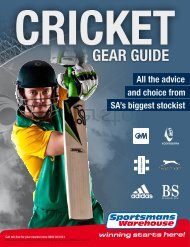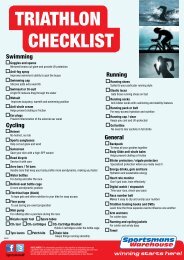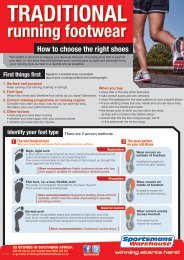Sportsmans Warehouse
Sportsmans Warehouse
Sportsmans Warehouse
You also want an ePaper? Increase the reach of your titles
YUMPU automatically turns print PDFs into web optimized ePapers that Google loves.
sKaTeBOarD components<br />
deck • grip tape • trucks • hardware • wheels • bearings<br />
Deck<br />
Material: Most decks are constructed from between 6- and 9-ply laminated wood -<br />
chinese maple (for entry-level boards) or canadian maple (for high-end boards). Some are strengthened<br />
with materials such as fibreglass, bamboo, resin, Kevlar, carbon fibre, aluminium and plastic.<br />
Size: Modern decks vary in size, but most are 7 to 10,5 inches (17,78 to 26,67 cm) wide. Your choice will be<br />
influenced by your foot size. Wider decks provide greater stability for transition or ramp skating. Narrower decks<br />
allow for quick rotation. Length of board varies between 28 and 33 inches (71,12 and 83,82 cm).<br />
The longboard, a common variant also called a cruiser, is mostly ridden down hills or on beachside pavements<br />
or boardwalks to mimic wave-riding.<br />
construction: A skateboard has an upturned nose and tail and a concave centre. The nose is usually longer and<br />
thicker than the tail. Both are called ‘kicktails’ and they are vital in manoeuvring the board, particularly for street<br />
skateboarding. They help with big tricks, pivots, slides, ollies (where rider and board leap into the air without the<br />
rider using his hands) and more.<br />
Wheelbase: The distance between the two sets of mounting holes drilled into the<br />
deck for the trucks is usually about 13 to 15 inches (33 to 38 cm). Taller people<br />
prefer a wider wheelbase, which lets them widen their stance while skating.<br />
wheelbase<br />
Grip tape<br />
This is a rough material that enables your feet to grip the deck. It has a surface like fine sandpaper on one side and<br />
adhesive on the other. Replacement grip tape is available in varying levels of coarseness. While it is usually black,<br />
other colours, as well as clear, are available. You can get creative and cut shapes<br />
into your grip tape, e.g. to show a graphic on the board underneath.<br />
truckS<br />
These connect the wheels to the deck and are usually made from aluminium alloy. Each skateboard has two trucks,<br />
each with two wheels. Trucks have tough, adjustable bushings which help the rider steer the board, as he or she<br />
applies more weight to one side of the deck.<br />
The baseplate of each truck is screwed to the deck and underneath it is the hanger,<br />
with the axle running through it. Between the two are bushings and rubbers or<br />
grommets. A kingpin holds these together and by tightening or loosening the kingpin nut,<br />
the trucks can either be loosened for better turning or tightened for increased stability.<br />
A variety of axle widths is available. Wider axles are used for wider boards.<br />
The special trucks for longboards have a kingpin at a more obtuse angle, which permits less turning for the same tilt<br />
of the deck, thus allowing riders to go faster, with a wider carving motion, while still keeping stable and in control.<br />
MountinG harDWare<br />
Eight 10-32 UNC bolts, usually with an Allen or Phillips head, together with matching nylon locknuts, are used to<br />
attach the trucks to the skateboard. Some sets may have one differently coloured bolt which indicates which side<br />
must face the nose of the skateboard.<br />
hanger<br />
baseplate<br />
kingpin<br />
axle<br />
grommet<br />
WheelS<br />
Size: The larger wheels (54 to 85 mm diameter) roll faster and cope<br />
better with cracks in the pavement. Smaller wheels (48 to 54 mm)<br />
keep the board closer to the ground, resulting in a lower centre of<br />
gravity. They need less force to accelerate.<br />
Material: Advanced polymers are used, usually polyurethane.<br />
Degree of hardness: This is measured by a Durometer and is mostly<br />
expressed as somewhere on the ‘A-scale’ which extends from 70 - 100.<br />
The higher the A-scale number, the harder the wheel. An average street<br />
skateboard wheel is 95A, and softer wheels can be 70A or even lower.<br />
Which wheel for your purpose?<br />
A good general choice is wheels between 52 and 54 mm, with 99A hardness.<br />
For riding ramps (or ‘verts’/vertical ramps) you want to roll much faster, so choose<br />
larger wheels (55 to 65 mm) with a hardness of 95-100A. (Start with 60 mm wheels.)<br />
Slalom skating demands the highest possible speeds, so choose even larger wheels<br />
of 60 to 75 mm, with a softer A rating. Longboarding/cruising and downhill<br />
skateboarding require large wheels (65 to 100 mm), which are softer (78A to 85A)<br />
for riding over rough terrain. For flip tricks many street/technical skateboarders prefer<br />
smaller wheels, which are lighter and closer to the ground, such as those 50 to 55 mm,<br />
with a hardness of 97A to 100A. A good all-terrain choice is a wheel size of<br />
52 to 60 mm, with 95A to 100A hardness, which gives a balance between speed<br />
and weight. In general 95A is an average wheel hardness for street skateboarding.<br />
BearinGS<br />
analyse<br />
the action<br />
A skateboard wheel is mounted on its axle by means of two bearings. These bearings are usually<br />
the standard 608 size and are made from steel, with a bore of 8 mm, an outer diameter of 22 mm<br />
and a width of 7 mm. Bearings enable the wheels to rotate freely at high speed and will have to be<br />
replaced occasionally. Do not skate in wet conditions, as this will ruin bearings.<br />
The ABEC scale for bearings:<br />
This is an American 1 – 9 scale for rating the accuracy of tolerance of bearings. (It does not measure<br />
how well a bearing will handle side-to-side loads, which can be severe with skateboard movement.)<br />
ABEC 3 applies to most inexpensive complete skateboards<br />
ABEC 5 is the norm for recreational skateboarding<br />
ABEC 7 bearings are very fast and smooth<br />
ABEC 9 bearings are extremely highly spec’d and are used in the most advanced boards<br />
optional coMponentS<br />
• risers increase the space between truck and deck, permitting the truck to twist further without causing the wheel<br />
to ‘bite’ the deck and stop turning.<br />
• rails or ribs are strips of plastic or metal affixed under the deck along its edges. Although rarely used today,<br />
they can provide the experienced skater with extra grip for grabs, they can enhance sliding, plus they can<br />
protect the graphics of the deck’s underside.<br />
• Wedges can be used to alter a truck’s turning characteristics.<br />
• Slip tape or ever-slick is a clear, self-adhesive plastic stuck to the deck’s underside for protection and easier sliding.<br />
E&OE







